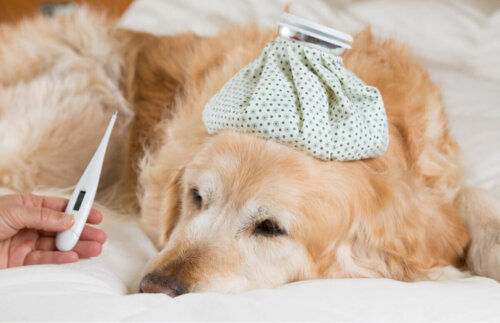Check Out These Eight Tips for Treating Colds in Dogs


Reviewed and approved by the biologist Samuel Sanchez
There are many anatomical differences between humans and dogs but colds can afflict this animal as much as it does us, and so treating them promptly is a must.
As you can see, we do share certain behaviors and diseases. In addition, the symptoms of colds in dogs are somewhat similar to the ones for distemper virus or infectious tracheobronchitis — known as kennel cough. However, the causes and treatments of each disease are different. Let’s concentrate on colds in dogs though.
The causes of colds in dogs
Let’s start by saying that sneezing isn’t necessarily a symptom of a cold. There are certain ones that’ll indicate a cold for sure. However, sneezing on its own doesn’t confirm a diagnosis.
Any dog can catch a cold when exposed to strong temperature changes and drafts. This is common when they go out of the house in wintertime and humans don’t realize that they must keep them dry and clean. We also sort of encourage it by not keeping up with their vaccinations.

Symptoms of colds in dogs
The first general symptoms of colds in dogs are:
- Frequent sneezing accompanied by nasal discharge means the dog is trying to excrete excess mucus and pathogens
- Severe coughing accompanied by mild vomiting is due to inflammation of the upper airways, which also involves the upper digestive tract
- Loss of appetite and watery eyes
- General discomfort such as muscular weakness, poor sleep, and fever means the animal’s immune system is focusing exclusively on fighting the infection
These signs can last between one and two weeks. In this case, you should ideally take your dog to a veterinarian for a proper check-up. Colds are usually harmless, but other diseases with similar symptoms could be lethal to the animal if not treated in time.
Treating colds in dogs
Here’s a list of eight tips to keep in mind if your dog catches a cold:
- Consult a vet about fluid therapy. It consists of balancing the internal fluids in the dog’s nasal passages.
- You must consult a vet for a prescription of antibiotics if the cold is due to bacteria
- Puppies get sick with colds so you must strengthen their immune system with a diet rich in immunonutrients.
- A dog may have diseases that promote colds so you must provide them with vitamins, especially A, C, and E.
- A dog can catch a cold due to cold temperatures so you must keep the animal’s temperature balanced with a sweater or a coat.
- Once the dog has contracted the disease, you must consult a veterinarian for a prescription of expectorants in order to expel the accumulated bronchial secretions.
- It may seem irrelevant, but pampering the dog contributes to the improvement of their mood and can, therefore, help them recover from a cold.
- Encouraging the dog to eat well and drink plenty of water is vital during an illness. They should also be left alone so they can rest.

Preventing colds is better than treating them
Colds in dogs are common but it doesn’t mean this symptomatology is of little importance. A poorly cared-for cold can turn into bronchopneumonia, so you must take it seriously.
Mainly, you must be able to detect the symptoms of a cold early and take them to the vet asap. It’s the responsible thing to do and a great way to show them your love and respect.
All cited sources were thoroughly reviewed by our team to ensure their quality, reliability, currency, and validity. The bibliography of this article was considered reliable and of academic or scientific accuracy.
https://www.affinity-petcare.com/vetsandclinics/es/perro-resfriado-como-actuar-en-esta-situacion#:~:text=Los%20s%C3%ADntomas%20m%C3%A1s%20comunes%20del,ir%20acompa%C3%B1ada%20de%20v%C3%B3mitos%20leves.
https://www.kivet.com/como-evitar-que-tu-perro-se-resfrie-en-invierno/
https://ceba.com.co/perro-resfriado-como-actuar-en-esta-situacion/
https://www.20minutos.es/noticia/4574224/0/resfriados-en-perros-sintomas-y-tratamientos/?autoref=true
This text is provided for informational purposes only and does not replace consultation with a professional. If in doubt, consult your specialist.